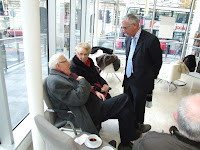Frank McKelvey
 |
| Frank McKelvey |
Frank's father, William, was a painting contractor, and in his early years Frank worked from his father's premises on the Woodvale Road. He first exhibited at the Royal Hibernian Academy in 1918 and his landscape painting won him immediate recognition in Dublin. He continued exhibiting at the R.H.A. every year for the next fifty-five years, showing from three to eight works each time.
McKelvey became a full-time painter of landscapes and portraits, opening his first studio at 142 Royal Avenue around 1919, next to that of artist J.W. Carey (1859-1937) and exhibiting mostly in Belfast, Dublin and Glasgow. His landscape paintings are typically of farm scenes in Co Armagh, the North Coast, and later in Co Donegal. Thomas McGowan commissioned him, together with other local artists, to paint pictures of old Belfast, and this collection is in the Ulster Museum. As a member of the RHA, he exhibited in Belfast, Dublin and Londonderry, and in 1936 had a one-man show where three of his landscapes were purchased as a wedding present for Queen Juliana of the Netherlands by Dutch people living in Ireland.
McKelvey also painted many portraits, amongst them the mathematician and physicist Sir Joseph Larmor; the Lord Mayor of Belfast, Sir Martin Wallace; Sir William Whitla; the 3rd Duke of Abercorn and Professor Sir William Thomson. Thirteen of his large-scale portrait drawings of U.S. Presidents with Ulster lineage were presented to the Belfast Museum & Art Gallery in 1931. He also illustrated Margaret Holland's book My Winter of Content under Indian Skies.
His work can now be found in the Royal Collection at The Hague and in many places in Ireland including the Crawford Gallery, Cork; Queen's University, Belfast; the Ulster Museum and the Masonic Hall in Dublin. In London the National Maritime Museum houses one of his paintings depicting an Aran Island currach.
Frank McKelvey died on 30 June 1974 in Belfast.
The Unveiling
 |
| Chris Spurr |
Alderman Christopher Stalford said that as Chair of the Council's Development Committee he was delighted to support this and other initiatives throughout the City. In Belfast awareness of he positive impact that many Belfast people have had both here and in shaping the world was becoming increasingly recognised. It was therefore entirely appropriate to commemorate Frank McKelvey for the contribution he had made. He spoke about the view of art before McKelvey's time as 'art without roots' and said the McKelvey had helped to give it those roots, quoting from John Hewitt (another Belfast man). He thanked the Ulster History Circle and all those present for being here to commemorate Frank McKelvey.
 |
| Dr Brian Kennedy, Alderman William Humphrey MLA, Cllr Naomi Thompson, Frank McAllister (owner of 56 Woodstock Road)and Alderman Christopher Stelford |
 |
| Anne McKelvey and Trevor Kennedy unveil the plaque |
Dr Brian Kennedy (McKelvey's Biographer), spoke of the view in the early 1920s that Irish Artists should paint Irish subjects and how Humbert Craig, Paul Henry and Frank McKelvey (all three of them being Belfast men) had developed this genre Irish Landscape painting during the inter-war years.
McKelvey's daughter-in-law, Mrs Ann McKelvey and his nephew, Trevor Kennedy spoke briefly to give some reminiscences of the artist and to thank the Circle and the people of the Shankill for this tribute to him.




